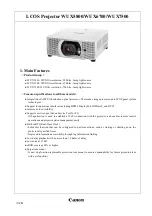
GLOSSARY
Roadie 25K User’s Manual
A-7
The phase in film-making that occurs primarily after production ends; its processes
include picture editing, sound effects editing and mixing, ADR, Foley, titles and
opticals, dubbing and print mastering, CGI and visual effects, and scoring. Post
production culminates in acceptance of the original negative answer print. Even
though post production officially begins on the last day of principal photography,
post production facilities such as editing are utilized from very early in the
production phase in order to save time.
The distance between the projector's front feet centers and the screen. More
commonly known as "Throw Distance”.
Shifting the frequency, sample rate, or frame rate to as to achieve a target frequency
or time relationship with another signal, most commonly by +/- .1%–the ratio of
NTSC to B&W TV frame rates. See: 3:2 pulldown.
A selectable menu item that unfolds into a list of options or choices.
A manufacturer of a digital video recorder/player/server, QuBit, frequently used for
providing digital cinema data. QuVis image compression uses a proprietary
technology called Quality Priority Encoding, based on wavelets, in which the user
selects a quality level based on signal-to-noise ratio. The data rate varies to
efficiently maintain that quality level. Frames are coded individually.
A translucent panel for screen projection. Incident light travels through the incident
surface of a rear screen and forms an image on the other surface. Rarely used for
cinema applications.
Composite positive motion picture prints, generally made from internegatives,
intended for distribution to exhibitors.
The ability to manipulate the physical size, placement and/or aspect ratio of an
image. Also called scaling.
The maximum number of pixels that the projector can display horizontally and
vertically across an image, such as 1400 x 1050 (SXGA+) or 2048 x 1080.
The minimum time required for a CRT projector to move the position of the scanning
spot from the right edge to the left edge.
The video output (analog or digital) of most computers. Analog RGB video can have
3, 4, or 5 wires — one each for red, green, and blue, and either none, one or two for
sync. For three-wire RGB, the green wire usually provides sync. (See TTL Video).
A common asynchronous data transmission standard recommended by the
Electronics Industries Association (EIA). A type of serial communication.
A less common asynchronous data transmission standard in which balanced
differential voltage is specified. RS422 serial communication is especially suited to
long distances.
The output from certain video tape players and video equipment. S-Video separates
sync and luminance from color information, typically producing a higher quality
display than composite video. Also known as Y/C.
The horizontal or vertical frequency at which images are generated. Also known as
scan rate or refresh rate.
Post
Production
'
Projector-to-Screen
'
Distance
Pull
Up (Pull Down)
'
Pull-down
List
'
QuVis
'
Rear
Screen
'
Release
'
Resizing
'
Resolution
'
Retrace
Time
'
(Horizontal)
RGB
Video
'
RS232
'
RS422
'
S-Video
'
Scan
Frequency
'
Summary of Contents for Roadie 25K
Page 6: ......
Page 56: ......
Page 153: ...SPECIFICATIONS Roadie 25K User s Manual 6 7 ...
Page 164: ......
Page 165: ...Appendix B Remote Keypad Roadie 25K User s Manual B 1 Figure B 1 Standard Remote Keypad ...
Page 166: ......
Page 168: ...SERIAL COMMUNICATION CABLES C 2 Roadie 25K User s Manual ...
Page 169: ...SERIAL COMMUNICATION CABLES Roadie 25K User s Manual C 3 ...
Page 170: ......
Page 186: ......
















































